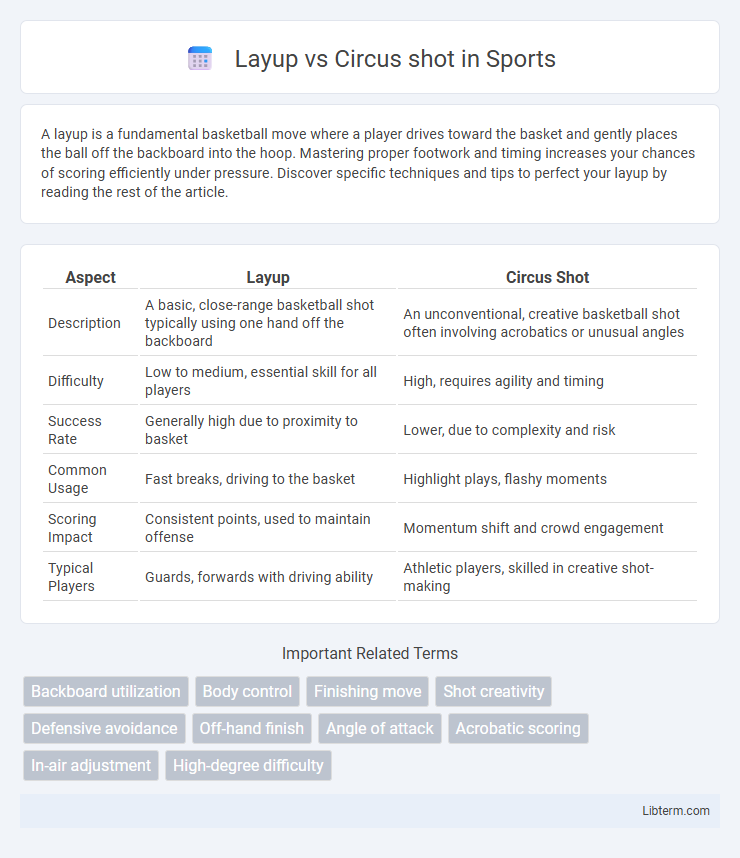A layup is a fundamental basketball move where a player drives toward the basket and gently places the ball off the backboard into the hoop. Mastering proper footwork and timing increases your chances of scoring efficiently under pressure. Discover specific techniques and tips to perfect your layup by reading the rest of the article.
Table of Comparison
| Aspect | Layup | Circus Shot |
|---|---|---|
| Description | A basic, close-range basketball shot typically using one hand off the backboard | An unconventional, creative basketball shot often involving acrobatics or unusual angles |
| Difficulty | Low to medium, essential skill for all players | High, requires agility and timing |
| Success Rate | Generally high due to proximity to basket | Lower, due to complexity and risk |
| Common Usage | Fast breaks, driving to the basket | Highlight plays, flashy moments |
| Scoring Impact | Consistent points, used to maintain offense | Momentum shift and crowd engagement |
| Typical Players | Guards, forwards with driving ability | Athletic players, skilled in creative shot-making |
Understanding Layups: The Basketball Basic
Layups represent the fundamental scoring technique in basketball, emphasizing close-range shooting performed by driving toward the basket and using the backboard for precision. Typically executed with one hand while moving, layups enable players to maximize speed and control, increasing the likelihood of scoring against defenders. Mastering layups builds essential skills such as footwork, timing, and body coordination, forming the basis for more advanced moves like the circus shot, which introduces creativity and acrobatic elements to elevate offensive plays.
Defining the Circus Shot: Flash and Flair
The circus shot in basketball is defined by its extraordinary flair and flash, combining acrobatic movement with precision to score in seemingly impossible situations. Unlike the standard layup, this shot involves unconventional angles, spins, or airborne contortions that captivate audiences and challenge defenders. Players like Kyrie Irving and Jamal Crawford have popularized the circus shot by seamlessly integrating creativity with technical skill, elevating the art of scoring near the basket.
Technical Breakdown: Mechanics of a Layup
The mechanics of a layup involve precise footwork, body control, and hand placement to ensure smooth execution near the basket. Players typically use a one- or two-foot takeoff, guiding the ball off the backboard with the fingertips to avoid defenders. This contrasts with the circus shot, which demands more acrobatic maneuvers and creative angles to score under extreme defensive pressure.
Execution and Difficulty: How Circus Shots Stand Out
Circus shots distinguish themselves from layups through their complex execution involving acrobatic moves, behind-the-back passes, or off-balance finishes that demand exceptional body control and spatial awareness. Unlike the relatively straightforward approach of layups, circus shots often require precise timing and high difficulty, making them rare and crowd-pleasing plays. Their successful completion showcases advanced skill levels, elevating a player's highlight reel and basketball IQ.
Situational Usage: When to Choose a Layup
A layup is the optimal choice when approaching the basket from a close range with a clear path, allowing for a quick, controlled shot using the backboard. It is most effective during fast breaks or when defenders are well-positioned, as its high-percentage shot minimizes the risk of turnovers. Conversely, the circus shot is reserved for last-moment creativity under intense defensive pressure or awkward angles where a standard layup is not feasible.
High-Risk, High-Reward: The Circus Shot Advantage
The circus shot in basketball presents a high-risk, high-reward advantage due to its unpredictable and flashy nature, often catching defenders off guard and increasing scoring opportunities in tough situations. Unlike the layup, which relies on controlled and straightforward execution, the circus shot involves acrobatic moves that can bypass tight defense and generate highlight-worthy points. This shot capitalizes on creativity and athleticism, making it a valuable asset in clutch moments where traditional plays may be heavily contested.
Success Rates: Which Shot Scores More?
Layups consistently demonstrate higher success rates in basketball due to their close-range execution and controlled shot mechanics, often converting over 60% of attempts in professional leagues. Circus shots, characterized by acrobatic, unconventional moves, have significantly lower field goal percentages, typically below 40%, due to increased difficulty and reduced shot accuracy. Statistical analysis of NBA data confirms layups as a more efficient scoring option compared to the more visually spectacular but less reliable circus shots.
Defensive Reactions: Guarding the Layup vs Circus Shot
Defensive reactions to guarding a layup focus on positioning and timing to block or alter the shot with minimal risk of fouling, as layups follow predictable trajectories close to the basket. In contrast, guarding a circus shot requires heightened awareness due to its unconventional angles and creativity, making it difficult to anticipate and defend without committing fouls. Defenders must evaluate shot difficulty and adjust their spacing to avoid being easily deceived by the circus shot's unexpected release and body contortions.
NBA Highlights: Iconic Layups and Circus Shots
NBA highlights showcase iconic layups and circus shots as thrilling displays of player agility and creativity near the basket. Layups typically involve a controlled, close-range shot using the backboard, emphasizing precision and finesse, while circus shots feature acrobatic, unexpected maneuvers often made under extreme defensive pressure. Legendary players like Michael Jordan and Kobe Bryant epitomize these electrifying moves, turning highlight reels into unforgettable moments of basketball artistry.
Training Tips: Mastering Each Shot Type
Mastering layups requires consistent practice on footwork, angle approach, and timing to improve accuracy and speed near the basket. Circus shots demand advanced ball control, creativity, and body coordination training to execute unconventional spins and bank shots under pressure. Incorporating targeted drills such as cone footwork exercises for layups and hand-eye coordination challenges for circus shots enhances overall shooting versatility and performance.
Layup Infographic

 libterm.com
libterm.com